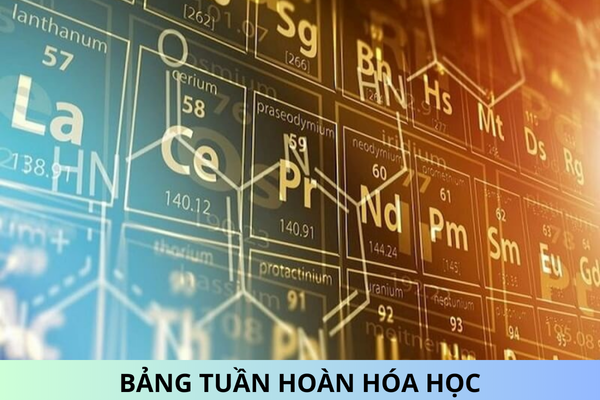What are details of the Periodic Table of Chemistry? What are levels of the National Education System of Vietnam?
What are details of the Periodic Table of Chemistry?
The periodic table of chemistry, also known as the periodic table of chemical elements, is an organized chart arranging chemical elements based on their chemical characteristics, physical properties, and atomic number (the number of protons in the nucleus).
The periodic table is a crucial tool in chemistry and related sciences, aiding scientists and students in easily referencing and understanding chemical elements and their relationships.
[1] Periodic Table of Chemistry for Grade 8 Students (Reference Model)

[2] Periodic Table of Chemistry for Grade 9 Students (Reference Model)

[3] Periodic Table of Chemistry for Grade 10 Students and Above (Reference Model)

The periodic table of chemical elements includes three basic components:
- Element cells: Each cell in the periodic table contains a chemical element. The order number of the cell is the atomic number of the element inside.
- Periods: Consisting of 7 periods, these are sequences of chemical elements with the same number of electron shells and are arranged in increasing order of nuclear charge. The order of the period is the number of outermost electron shells of the element. Here, periods 1, 2, 3 are small periods; and periods 4, 5, 6, 7 are large periods (the 7th period is not yet complete).
- Groups of elements: These are chemical elements with similar electron configurations, resulting in similar properties and are arranged in a column. Elements s and p belong to group A, while group B contains elements d and f.

What are details of the Periodic Table of Chemistry? What are levels of the National Education System of Vietnam? (Image from the Internet)
What are levels of the National Education System of Vietnam?
Pursuant to Article 6 of the Education Law 2019, the national education system is defined as:
Article 6. National Education System
- The national education system is an open and interconnected system comprising formal education and continuing education.
- The levels and qualifications in the national education system include:
a) Preschool education consists of nursery and kindergarten education;
b) General education includes primary education, lower secondary education, and upper secondary education;
c) Vocational education provides elementary level, intermediate level, college level, and other vocational training programs;
d) Higher education provides bachelor's, master's, and doctoral degrees.
- The Prime Minister of the Government of Vietnam decides to approve the Framework for the National Education System structure and the Vietnam National Qualifications Framework; specifies the duration of training, standards for each training level, and minimum study load for vocational and higher education levels.
- The Minister of Education and Training, the Minister of Labor, Invalids, and Social Affairs, within their duties and powers, stipulate the entrance thresholds for college and university levels in teacher training and health fields.
Thus, the national education system comprises the following levels:
- Preschool education includes nursery and kindergarten education
- General education includes primary education, lower secondary education, and upper secondary education
- Vocational education provides elementary level, intermediate level, college level, and other vocational training programs
- Higher education provides bachelor's, master's, and doctoral degrees
What are requirements for educational methods in Vietnam?
According to Article 7 of the Education Law 2019, the requirements for educational content and methods are specified as follows:
Article 7. Requirements for Educational Content and Methods
- The educational content must ensure basic, comprehensive, practical, modern, systematic, and regularly updated qualities; focus on educating ideology, moral character, and citizenship awareness; inherit and promote the good traditions, cultural identity of the nation, and absorb the cultural quintessence of humanity; suitable with the physical, intellectual, psychological development and abilities of learners.
- Educational methods must be scientific, promote the active, self-disciplined, proactive, creative thinking of learners; foster learners' self-learning ability and cooperation, practical skills, passion for learning, and the will to rise.
Thus, the education method must be scientific, promote the active, self-disciplined, proactive, creative thinking of learners; foster learners' self-learning ability and cooperation, practical skills, passion for learning, and the will to rise.










